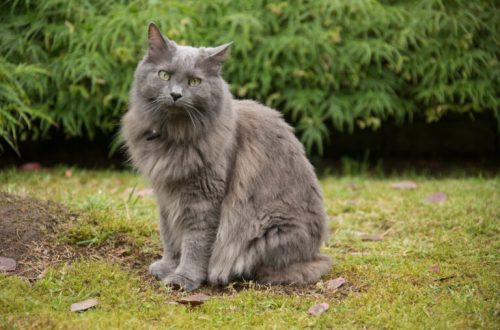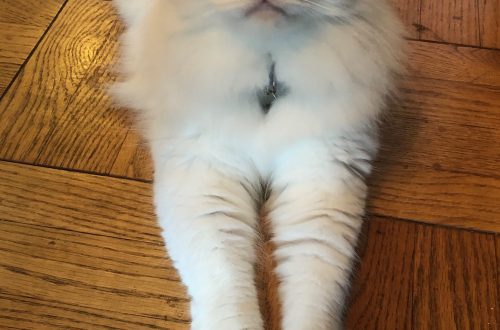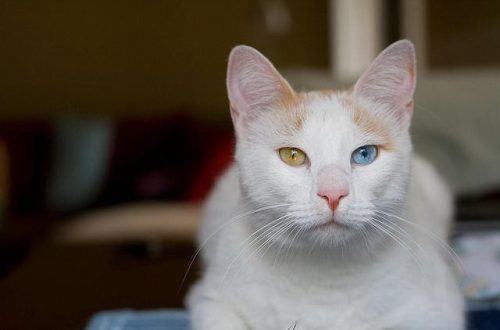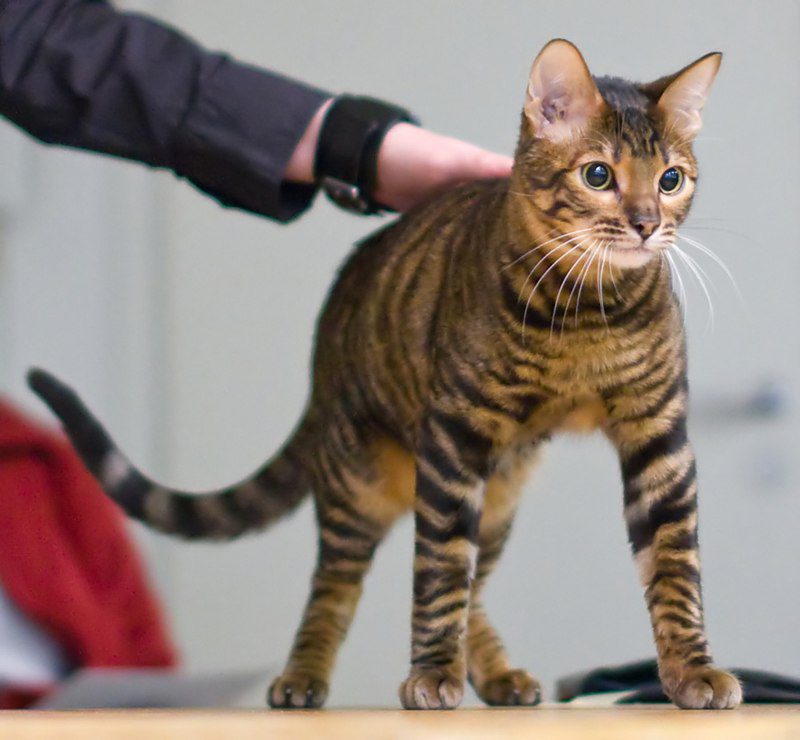
Toyger
Toyger is a short-haired cat of brindle color and strong build, with a friendly, sociable character. The breed was bred in the USA in the late 80s of the XX century, and so far remains in developing status.
Contents
Characteristics of Toyger
| Country of origin | USA |
| Wool type | Shorthair |
| Height | 30–40 cm |
| Weight | 4–9 kg |
| Age | 12–18 years old |
Basic moments
- The name “toyger” is formed by merging two English words: toy – toy and tiger – tiger.
- Representatives of this breed are smart cats that lend themselves well to training. They quickly get used to walking on a harness and are able to perform simple acrobatic tricks.
- Toygers are tigers only in appearance. By nature, these are quite peaceful and good-natured cats, always ready to join the game proposed by the owner.
- This is one of the most trouble-free breeds in terms of care. Shedding in toygers takes place at a very sluggish pace, which frees the owner from the need to constantly comb the pet and endlessly vacuum the apartment.
- Toygers do not have problems with obedience, but if the cat does not like something, he will definitely express his own opinion with a loud meow. As an example: the breed does not like carrying bags and, once inside, the toyger will certainly try to notify others about the infringement of his rights.
- It is believed that the hunting instincts of cats are muffled, however, it will not work to make friends with a toyger with a hamster or a parrot.
- Toygers do not have inherent hydrophobia. This is one of those rare breeds, for whose representatives going to the bathroom is not a tragedy, but an ordinary hygienic procedure.
- Toygers become sexually mature cats at the age of five months, while the psychological and physical maturation of the animals is completed only by two years.
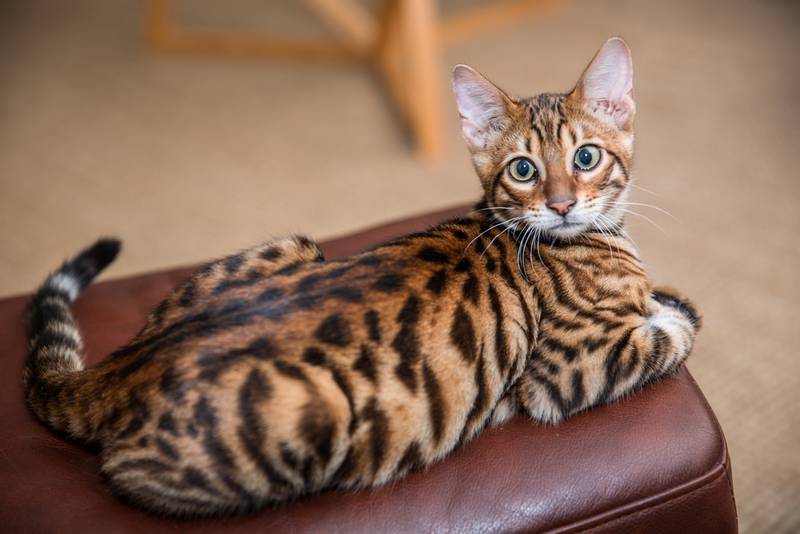
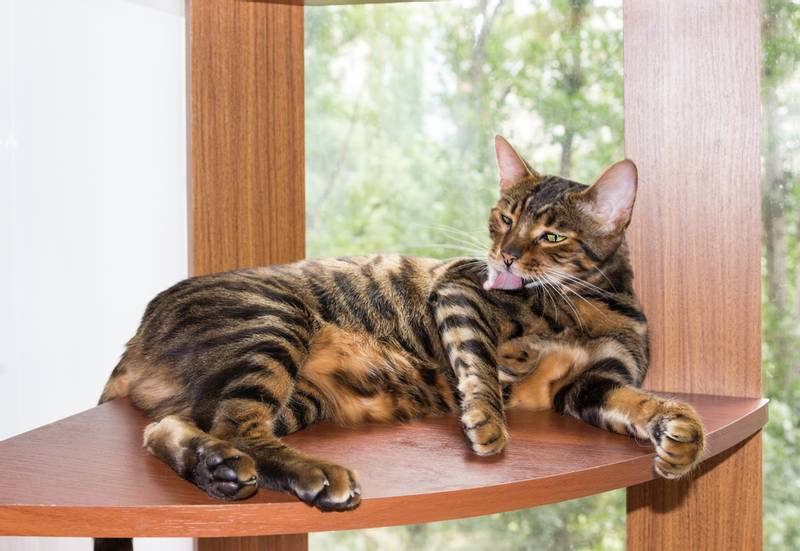
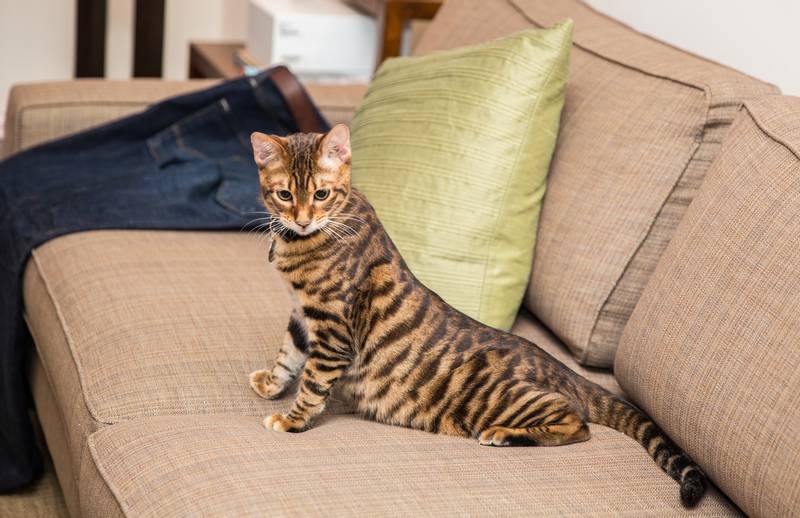
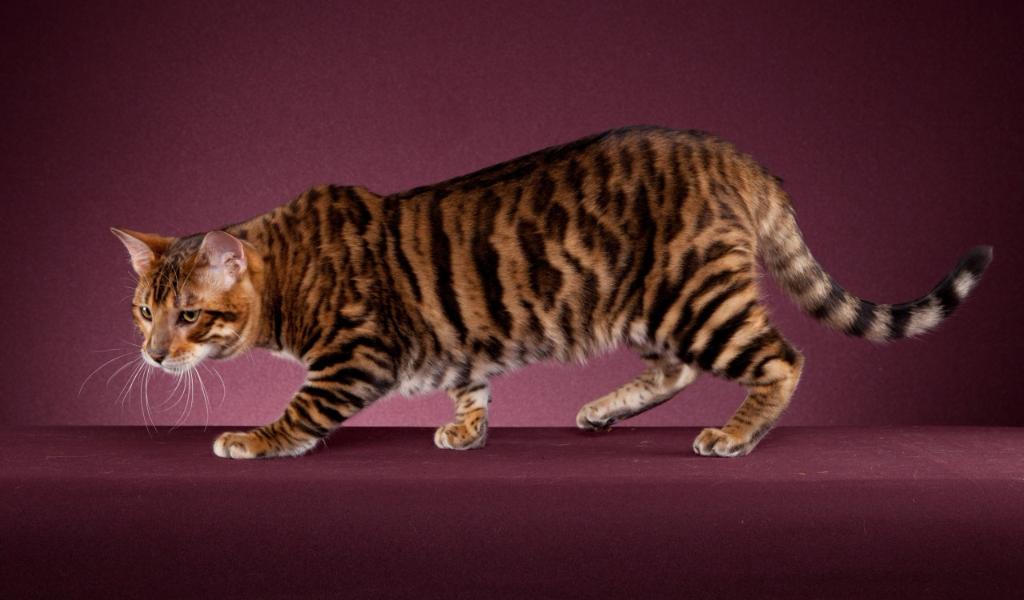
Toyger – about five kilograms of striped charm and playfulness, which is impossible not to fall in love with. Despite the close relationship with independent bengals , tiger cats did not go into their relatives in character. Non-conflict, balanced, sincerely attached to the person and the house, toygers have every right to be considered, if not ideal, then quite trouble-free pets. The breed has only one drawback – the excessive popularity of its representatives among animal lovers. And since increased demand does not always give rise to a quality supply, it is still easy to acquire a mestizo or an unsuccessful breeding product with a lot of external defects under the brand name “domestic tiger”.
Video: Toyger
Toyger breed history
Toygers are an entirely American “invention”. Once a resident of Los Angeles, Judy Sugden wanted to create a new kind of cat, resembling the appearance of tigers. It cannot be said that the idea came to the woman suddenly. Judy’s mother is an American breeder Jean Mill, the founder of the Bengal cat breed , so the breeder had someone to adopt the breeding experience. In addition, the woman was unexpectedly lucky when one of her Bengal wards gave birth to a kitten with striped marks on her temples.
It would not be an exaggeration to say that a toyger is a puzzle cat that combines the appearance and character traits of several breeds at once. To breed a “domestic tiger” Judy Sugden attracted a wide variety of cats, ranging from Bengals and ending with domestic shorthairs, as well as outbred purrs. At the same time, the main “suppliers” of the striped genes of the breed remain a domestic cat named Scrapmetal and a Bengal Millwood Rumple Spotskin, which were later joined by a stray street cat Jamma Blue, taken out by a breeder from Kashmir.
The official year of registration of the toyger breed is 1993, when TICA experts agreed to include animals in their registries. However, striped cats began to take full part in the championships only in 2007. Eight years later, the Governing Council of Cat Fanciers (GCCF) became interested in the animals, which in 2016 assigned the breed provisional status. This allowed the toygers to get into the exhibitions organized by the oldest felinological association in the world.
The appearance of the toyger and its differences from the Bengal cat
From the point of view of modern felinologists, the correct toyger is such a tiger in miniature with a weighted front part of the body and the most contrasting stripes on the “fur coat”. Unlike most members of the feline family, for these minke whales, the subtlety of the silhouette is a serious drawback that no exhibition commission will turn a blind eye to. At the same time, the animal should not look like a clumsy “sofa dweller”, since an exemplary toyger is an energetic, strong cat-athlete, ready to be active at any moment.
Without sufficient experience in dealing with toygers, they can be mistakenly classified as a family of domestic bengals . In fact, there are a lot of differences between breeds, ranging from body features to color. Well, to be more precise, the toygers combined all the characteristics undesirable for their own ancestors: more impressive dimensions, a stretched body and a vertical arrangement of stripes on the wool.
Toyger cats are usually larger and more charismatic than cats, which have both more fragile bones and less muscle mass. In addition, “girls” often lack spectacular feathers on their chins and temples, while this feature is pronounced in males.
Head
Medium in size, with distinct contours, a long muzzle and a widely stretched zygomatic region. When viewed in profile, the cat’s head resembles half a hexagon in shape. The toyger’s chin is rounded, strong, but not protruding forward. The vibrissa pads are distinct, slightly puffy, giving the cat’s muzzle a resemblance to an inverted heart.
Nose
The nose of the cat-tiger cat is elongated, with a rounded nose bridge, greatly expanding towards the tip. The lobe is quite large, but without obvious depth.
Eyes
The eyes of representatives of this breed should be small or medium in size. Usually the eyeball is set deep and at a slight inclination. The color of the iris is a rich yellowish green.
Ears
Toyger ears are miniature, wide set, with a neatly rounded tip. It is desirable that the ear cloth and temples be well pubescent, and too long hair, turning into tassels at the tip of the ear, is already a clear bust.
Frame
The main sign of the toyger breed is a massive, strongly stretched body with protruding shoulders and a weighted, wide chest.
limbs
The paws of toygers are strong, of medium length, which gives the silhouette of the animal an additional “tiger-like” appearance. Cat’s fingers are long and flexible.
Tail
Representatives of this breed have long, rope-like tails with a rounded, blunt tip.
Wool
Despite the fact that the toyger is in general a short-haired cat, her “fur coat” is thick, shiny and extremely soft. Another distinctive feature is the so-called 3D effect: usually the hair on the stripes is slightly longer than the hair on the background part of the body, which creates the illusion of additional volume. Cats often have small feathers on the temples and chin.
Color
The traditional color of toyger cats is brindle/mackerel with vertical dark stripes on a golden-red background (a small amount of grayish undercoat is acceptable). According to the rules, the background color should not be uniform. In particular, highlight areas on the abdomen, inside of the legs and chest are welcome. Well, the main rule of the breed: the maximum contrast between the red background, the tiger pattern and the highlighted areas.
Separately, it is worth mentioning the silver (snow) toygers, which have been sold for a long time, but still do not standardize. Such individuals are distinguished by a pale cream, almost white background color and a light brown striped “print”. By the way, the wool of the “snowballs” is softer in structure than that of the “tigers”.
Drawing features
The tiger pattern on the body, legs, neck and tail of the toyger should be vertical, wriggling and intertwining. An important point is the looping of the bands.
On the cat’s head, the “print” is placed in a circular manner, while the presence of vertical stripes in the area between the nose and the back of the head is undesirable. The dark color on the forehead of the toyger should be in the shape of a butterfly. The presence of a black outline of the lips, eyes and charcoal dots on the whisker pads is also welcome. Mandatory: whitish glasses around the eyes and dark ears with a light spot in the form of a fingerprint.
Defects and disqualifying vices
Any external feature that casts doubt on the purity of the animal is regarded as a serious defect. At exhibitions, for example, titles are not awarded to toygers of ticked color, with a belly and chest without stripes, blue-eyed individuals, and those with a tail tip of any shade other than black. Cats with malocclusion are subject to total disqualification.
Toyger character
Toyger’s life motto: “Moderation in everything and no extremes.” Affectionate, but not annoying, mobile, but not rushing around the apartment at a hurricane speed, this good-natured cat will become an exemplary companion for any animal lover. True, the breed has its own zest, which you will have to get used to – this is the irrepressible curiosity of its representatives. Toyger studies in detail everything that interested him, but sometimes he loses his vigilance and relaxes. At such moments, one can observe such oddities as a cat dozing in an open oven, washing machine or kitchen cabinet.
Independence, pride, resentment – the qualities that the toygers “forgot to put”. Accordingly, if you inadvertently offended the cat, he will not accumulate negativity and develop a revenge plan, but will prefer to forget about the incident. Painful injections, an accidentally crushed tail, tasteless medicine – the toyger accepts all the blows of fate listed without malice and philosophically. By the way, do not confuse the loyalty and good nature of the toyger with cowardice. These amusing tiger cubs are quite brave creatures, which, combined with natural curiosity, can lead to unpleasant consequences. In particular, flights from a balcony and through an open window, showdowns with dogs and relatives are all the result of a cat’s courage shown at the wrong time and in the wrong place.
Almost all toygers have such character traits as sociability and gullibility. Moreover, minke whales are not at all selective in expressing their own disposition. As a result: the cat plays with the same pleasure both with the owner and with his children, and in general with any person who finds himself on the threshold of the house and shows minimal interest in the animal. Toyger’s favorite pastime is to perch on the owner’s knees or stomach and, shifting from paw to paw, do a relaxing massage to his own background purr.
Do not discount the desire of the breed to be in the thick of things. A toyger will always prefer a pleasant party and the owner’s company to loneliness, so do not test your pet’s patience by locking him in an apartment for half a day. Remember, animals have a different perception of time, and even a couple of hours of forced confinement is regarded by them as a serious prison term.
Education and training
You can raise an obedient pet from a “cat tiger” without unnecessary hassle and the use of special techniques. Striped smarties work remarkably according to standard training programs, are easily included in the educational process, if only it is not too long, and quickly get used to the system of prohibitions-permissions. In particular, toygers are better than most cats at accepting the “No!” command. and willingly follow it.
With accustoming an animal to a tray, difficulties usually do not arise. Toyger is a naturally clean cat, preferring order in everything. So, bringing a kitten into the house, immediately equip a comfortable toilet and put the baby in it more often. After a couple of “potty landings”, the toyger begins to understand what is expected of him, and in the future uses the tray for its intended purpose.
From the first days, set limits for the kitten that are allowed, namely: no jumping on the stove (burnt paw pads hurt) and tables. If a young fidget tries to climb where it is not supposed to, hiss sharply at him or sprinkle some water from a spray bottle. But keep in mind that the latter method does not always work, since most toygers are not afraid of water. And of course, always generalize your own requirements, because no one, even the smartest cat in the world, will understand why he is allowed to take a nap in a chair, but it is forbidden to jump on that antique chair or great-grandmother’s chest of drawers.
Maintenance and care
Toygers, despite their pretentious appearance, are absolutely unpretentious creatures and do not require specific care. It is not even necessary to comb them, because the breed sheds once a year and is so inexpressive that this period in her life is easy to miss. However, if you want to please your cat, once a week go over her body with a brush: toygers respect massage, and the procedure is useful for hair growth.
With washing, everything is also wonderful: cats take bathing in the shower and in the bathroom as a matter of course. Actually, here you don’t even need an assistant: it’s quite possible to wash the toyger alone. Every two days the animal is supposed to brush its teeth. In addition, a weekly examination of the pet’s ear canal and the removal of excess sulfur secretions with a piece of cloth moistened with lotion or a cotton pad are necessary. It is recommended to monitor the length of the cat’s claws. In particular, twice a month it is useful for a toyger to “pedicure”, the rest of the time giving the cat the opportunity to polish its claws on a scratching post on its own.
Important: toygers are taken out for a walk only on a harness. On the street, “cat tigers” behave recklessly and can get lost or run into trouble in the form of angry dogs.
As for arranging a place for a pet, it is important to understand that a cat is not a dog and the “Place!” means nothing to her. Of course, build a house or a bed for the ward, but get used to the fact that most often the striped cunning will be reveled on the sofa or in your bed. Enthusiastic flower growers, when buying a toyger kitten with their own hobby, will either have to tie up or constantly monitor the integrity of the plants. Most indoor flowers are poisonous to all cats, and especially to purebreds. And this despite the fact that toygers, and in principle all cats, adore eating green spaces.
An interesting fact: toyger cats are more sociable and obedient than kitties. But the territory and uncastrated “boys” and “girls” of reproductive age mark with the same zeal.
Feeding
On the one hand, toygers are far from being gourmets, and on the other hand, these mustachioed-striped ones will never refuse an addition and an extraordinary snack. Since there are no special recommendations on the types of food for the breed, some breeders keep their wards on the “dry”, and some prefer the natural menu.
The advantages of the first option are that the right food, in addition to saturating the cat, solves a number of additional tasks. In particular, convenience in determining the portion rate, saving the owner’s time, as well as the absence of the need to purchase dietary supplements and vitamin complexes – the macro- and microelements necessary for the animal are already included in the “drying”.
There are more problems with natural nutrition, although toygers do not need special foods. Tiger cats will be sincerely happy with the standard menu based on lean meat and offal, seasoned with vegetables and cereals. True, balancing the diet in such a way that the pet’s body receives vitamins and minerals in a complete set is almost unrealistic. Accordingly, the animal will have to buy additional pharmacy supplements, and this is an additional expense.
Health and disease of toygers
It is believed that Toygers did not inherit the genetic ailments of their ancestors. In any case, the results of tests conducted by foreign breeders showed that the risk of progressive retinal atrophy and hypertrophic cardiomyopathy in tabby cats is lower than in Bengals . At the same time, the toyger is quite capable of catching standard feline infections, so it is better to vaccinate your pet against rabies, calicivirus, panleukopenia and rhinotracheitis in a timely manner.
How to choose a kitten
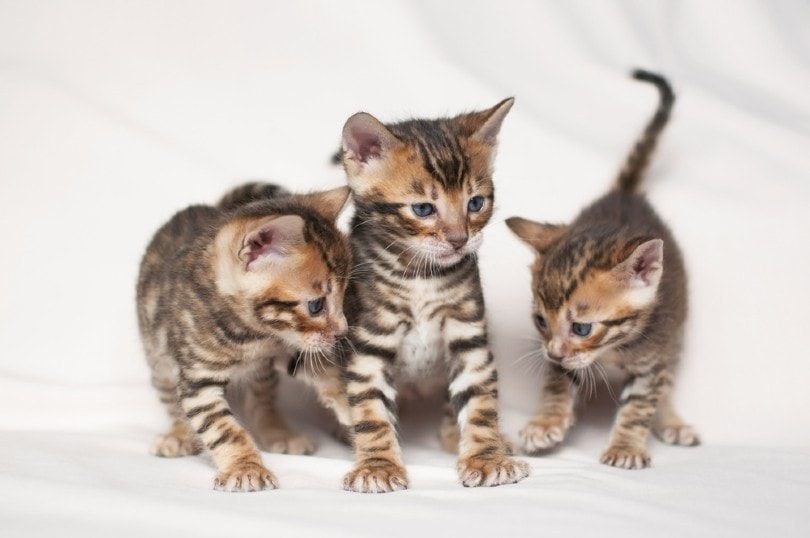
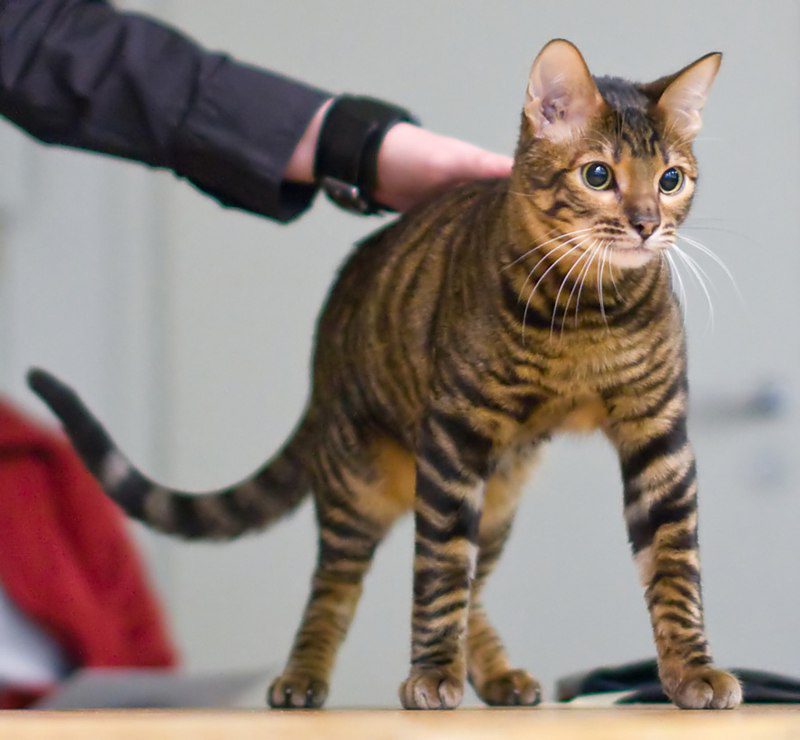

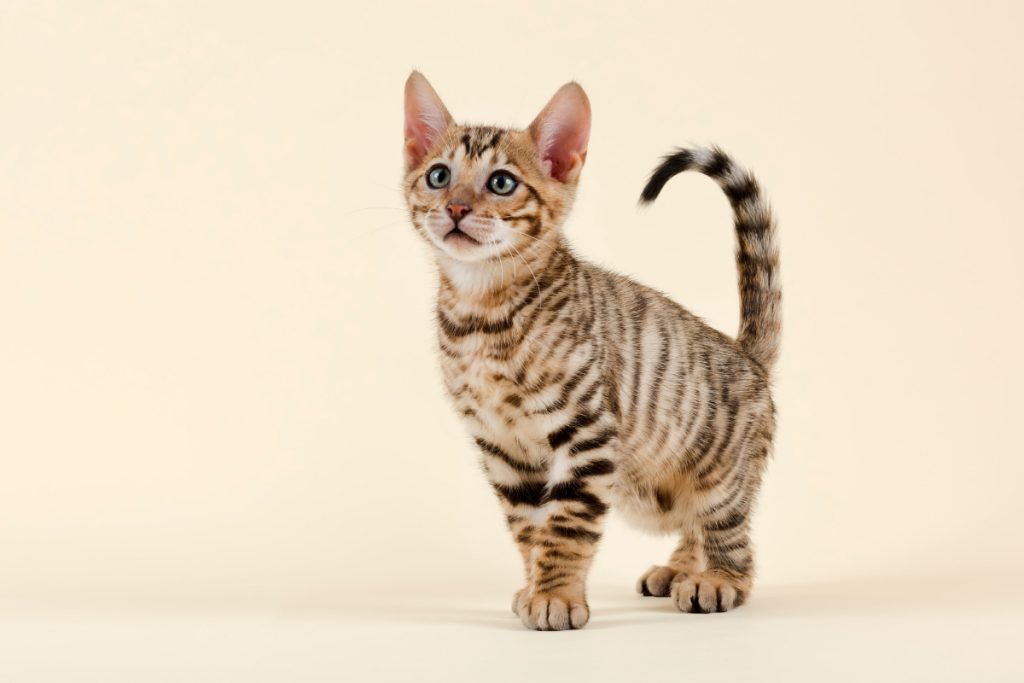
- Many domestic breeders keep both toygers and bengals at the same time , explaining this approach to breeding by the relationship of animals. However, to be on the safe side, it is better to choose TICA-registered kennels that specialize in only one breed.
- Take an interest in the exhibition achievements of the kitten’s parents and, in general, all the owner’s producers. If the seller explains the lack of diplomas of his wards by the bias of foreign judges, bring to his attention that the Russian toyger from the kennel “Tigervisions” is on the top list of the best representatives of the TICA breed for 2018.
- If the breeder confirms that his cattery is registered in the felinological system, ask him to show the Certificate of registration of the litter (Certificate of litter registration), as well as the Individual registration sheet of the selected kitten (Brider Slip), which contains data about the baby, including color and number his chip.
- Specify how many manufacturers the seller holds. If you are shown two toygers, it is unlikely that you will get high-quality offspring in this cattery. Breeding with just two individuals is a dead end.
- And of course, no hybrids! To date, crossing toygers with Bengals and any other breeds is prohibited.
Toyger price
The cheapest options are kittens with color defects and minor physical defects. Such toygers will cost about 450$. Individuals with a complete package of documents and a clear pedigree are valued at least 700 – 900$. Representatives of the breed and show classes cost the most. The cost of promising toygers can exceed 100,000 rubles.



